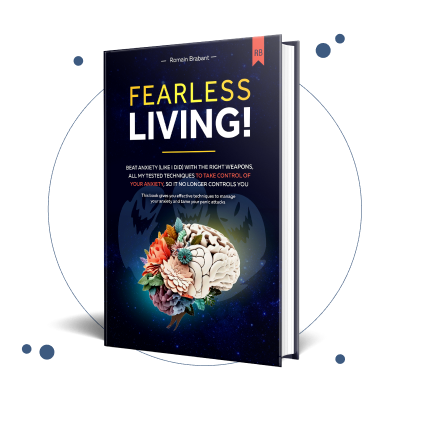
Living with anxiety can feel like being trapped in a constant storm of worry and panic, where every day is a battle against your own mind. It's exhausting, isolating, and it can steal the joy from your life. But what if you could find a way to navigate that storm, not by fighting it, but by learning to sail with it? What if you could reclaim your life from anxiety's grip and live freely, guided by what truly matters to you?
This isn't just wishful thinking; it's the promise of Acceptance and Commitment Therapy (ACT). This approach offers a hopeful and practical roadmap to heal from anxiety and start living a rich, meaningful life. The goal isn't to eliminate anxiety entirely—an often impossible task—but to change your relationship with it so it no longer controls your decisions or holds you back. For a broader array of strategies, a practical guide on how to reduce anxiety can offer additional tools and support for navigating stressful situations.
In this article, we will walk you through seven powerful acceptance and commitment therapy exercises designed to build psychological flexibility. These aren't just abstract concepts; they are actionable tools you can use today to begin your journey toward healing and lasting peace. Each exercise provides step-by-step instructions to help you defuse from difficult thoughts, connect with your values, and take committed action toward the life you want to live—a life free from the grip of panic.
1. The Observer Self Exercise: Finding the Calm 'You' Beneath the Noise
One of the most powerful acceptance and commitment therapy exercises, the Observer Self, offers a profound shift in perspective. It introduces you to a part of yourself that remains constant and untouched by life's chaos. This exercise helps you connect with the part of you that simply notices your thoughts, feelings, and sensations without being defined by them.
This concept provides a powerful anchor, especially for those navigating chronic anxiety or panic. It's the first step toward realizing that while feelings of panic are real and intense, they are temporary events you experience, not the core of who you are. This exercise builds a foundation of inner stability, offering tangible hope that you can find peace even when your mind feels like a storm.

How It Works: The Sky and the Weather
A popular metaphor used by ACT founder Steven Hayes is to imagine yourself as the sky. Your thoughts, emotions (like anxiety or fear), and physical sensations are the weather.
- The Weather: Clouds, storms, rain, and sunshine constantly change and pass through. Some days are turbulent, others are calm.
- The Sky: Regardless of the weather, the sky itself remains vast, open, and fundamentally unharmed. The storm doesn't damage the sky; it just occurs within it.
By connecting with this "sky-like" part of your consciousness, you learn to observe the "weather" of your anxiety without getting swept away by it. You are not the storm; you are the sky that holds the storm. This creates a crucial space between you and your difficult experiences, reducing their power and providing a real path to lasting calm.
Step-by-Step Guide
- Find a Quiet Space: Sit comfortably, close your eyes, and take a few deep breaths.
- Notice Your Thoughts: Allow your thoughts to come and go without judgment. Simply label them: "There's a thought about work," or "There's a worry about tomorrow."
- Acknowledge the Noticer: Now, shift your attention to the part of you that is doing the noticing. Realize that while the thoughts are changing, the "you" who is aware of them is constant.
- Extend to Emotions and Sensations: Expand this awareness to your emotions ("noticing a feeling of anxiety") and physical sensations ("noticing a tight chest").
- Rest in Awareness: Spend a few minutes resting in this observer perspective. You are the silent, steady witness to the ever-changing show of your inner world.
Key Insight: This practice isn't about stopping or changing your thoughts. It's about changing your relationship with them, moving from a place of fusion to a place of observation.
2. Leaves on a Stream Mindfulness Exercise
The Leaves on a Stream exercise is a cornerstone of acceptance and commitment therapy exercises, designed to change your relationship with your thoughts. It’s a visualization technique that helps you see your thoughts for what they are: temporary mental events that come and go, rather than absolute truths you must engage with.
This practice is incredibly empowering for those who feel trapped by intrusive, negative, or anxious thoughts. It provides a gentle yet effective method to step back and observe the mind's activity without getting caught in its current. For anyone struggling with the belief that their anxious thoughts control them, this exercise offers a tangible path toward freedom and proves that peace is possible, even when the mind is busy.

How It Works: Watching Thoughts Float By
The core principle of this exercise is cognitive defusion: the process of separating yourself from your thoughts. You imagine yourself sitting beside a gently flowing stream with leaves floating on its surface. Each thought that enters your mind is placed onto a leaf and allowed to float away.
- The Stream: Represents the natural, ongoing flow of your consciousness. It moves at its own pace.
- The Leaves: Your thoughts, feelings, and sensations are placed on these leaves. Whether the thought is "I'm a failure" or "I need to buy milk," it gets the same treatment. It is simply placed on a leaf and observed.
You don't push the stream, try to stop the leaves, or analyze their content. You simply watch them drift down and out of sight. This act of non-engagement teaches your brain that you don't have to react to every thought, powerfully reducing the grip of anxiety and depressive rumination. It’s a fundamental skill for anyone learning how to manage overwhelming thoughts. For more ways to calm your mind in the moment, you can discover a variety of grounding techniques for anxiety.
Step-by-Step Guide
- Find Your Stream: Close your eyes and visualize a beautiful, flowing stream. It can be in a forest, a meadow, or any peaceful setting you can imagine.
- Take Your Seat: Imagine sitting comfortably on the bank of the stream, just watching it flow.
- Notice a Thought: As a thought, image, or feeling appears in your mind, acknowledge its presence.
- Place It on a Leaf: Gently place that thought onto a leaf that is floating by on the stream.
- Watch It Go: Observe the leaf as it carries your thought along the water, moving toward you, passing in front of you, and eventually floating out of your sight.
- Repeat and Return: Continue this process with each new thought. If your mind wanders or you get hooked by a thought, gently notice that and guide your attention back to the stream.
Key Insight: The goal isn't to have an empty mind. It is to practice letting thoughts go, allowing you to choose where you place your focus rather than being pulled along by the current of your thinking.
3. Values Card Sort Exercise: Discovering Your Inner Compass
The Values Card Sort is one of the most foundational acceptance and commitment therapy exercises, designed to help you clarify what truly gives your life meaning. It provides a tangible way to explore and prioritize your core values, which act as a compass to guide your actions, especially when anxiety tries to take the wheel.
This exercise is particularly transformative for those feeling lost or stuck in a cycle of anxiety. It helps you reconnect with a deeper sense of purpose beyond the struggle with fear. By identifying what you want to stand for in life, you create a powerful motivation to move toward a richer, more meaningful existence, even when difficult feelings are present. This process offers immense hope, showing that your life can be about more than just managing anxiety; it can be about living fully and joyfully.

How It Works: Sorting What Matters Most
The exercise involves sorting a deck of cards, each listing a different value (like "Adventure," "Honesty," "Connection," or "Security"). You categorize these cards to create a clear hierarchy of what is most important to you.
- The Goal: The aim isn't to find the "right" values but to uncover your authentic values. This isn't about what you think you should care about, but what genuinely resonates deep within you.
- The Outcome: This process illuminates the "why" behind your desired life direction. When you know that connection with family is a core value, it becomes easier to make the difficult choice to attend a social gathering despite your anxiety. Your values provide the reason to act.
By clarifying your inner compass, you shift your focus from avoiding pain to pursuing meaning. This gives you a reason to be brave and offers a clear pathway out of the panic-driven loop, demonstrating that a life guided by purpose is absolutely achievable.
Step-by-Step Guide
- Gather Your Cards: Find a list of values online and write them on index cards, or use a pre-made deck. Aim for 50-100 different values.
- Sort into Three Piles: Create three categories: "Very Important to Me," "Somewhat Important to Me," and "Not Important to Me." Sort each card into one of these piles without overthinking.
- Prioritize Your Top Values: Take the "Very Important to Me" pile and narrow it down to your top 5-10 core values. This may be challenging, but it forces clarification.
- Reflect and Connect: Look at your chosen core values. Why are these so important to you? Reflecting on this can be a powerful experience, and for those interested in structured reflection, you can learn more about the benefits of journaling.
- Commit to Action: For each top value, brainstorm one small, concrete action you can take in the next week that aligns with it. For example, if "Health" is a value, commit to a 10-minute walk each day.
Key Insight: Values are not goals to be achieved; they are directions to be lived. This exercise helps you choose your direction so you can start taking meaningful steps, regardless of the emotional weather.
4. Creative Hopelessness Exercise: Finding Freedom by Letting Go
One of the most counterintuitive yet transformative acceptance and commitment therapy exercises is "Creative Hopelessness." This intervention guides you to honestly examine the strategies you've used to control your anxiety and pain, and to acknowledge that they haven't provided the lasting relief you crave. The goal isn't to foster despair but to create a powerful opening for a new, more effective path forward—a path toward true healing.
For anyone who feels stuck in a cycle of panic and anxiety despite trying everything, this exercise can be a profound turning point. It helps you stop digging a deeper hole with the same old shovel. By admitting the unworkability of your old control tactics, you create the space to pick up new tools that actually help you build a life free from the constant struggle against your inner experiences. It's the first step toward genuine liberation.
How It Works: The Person-in-the-Hole Metaphor
A common metaphor used to explain this concept is the "person in the hole." Imagine you've fallen into a big, deep hole and your only tool is a shovel. Your goal is to get out, so you do what seems logical: you start digging.
- The Problem: The more you dig (i.e., the more you try to suppress thoughts, avoid situations, or fight your anxiety), the deeper the hole gets. Your best efforts are making the problem worse.
- The Solution: Creative hopelessness is the moment you realize the shovel isn't working. The only way to get out is to put the shovel down and become open to a different solution, like someone throwing you a ladder.
This exercise helps you see how your attempts to control anxiety, often driven by cognitive distortions, have become the trap itself. By letting go of these ineffective strategies, you become receptive to the principles of acceptance and commitment, which offer a real ladder out of the hole toward a panic-free life.
Step-by-Step Guide
- Identify the Problem: Clearly name the internal experience you've been trying to control (e.g., "panic," "social anxiety," "worry").
- List Your Control Strategies: Write down everything you have done to try to get rid of this problem. Examples include avoiding social events, distracting yourself, arguing with anxious thoughts, or using reassurance-seeking behaviors.
- Evaluate the Short-Term Outcome: For each strategy, ask: "Did this give me any temporary relief?" Often, the answer is yes.
- Evaluate the Long-Term Outcome: Now, ask: "In the long run, did this strategy permanently get rid of the problem and bring me closer to the life I want?" Be brutally honest.
- Acknowledge the Cost: Reflect on what these control strategies have cost you in terms of time, energy, opportunities, and overall quality of life. The goal is to see that the "solution" has become a bigger problem than the original anxiety.
Key Insight: This isn't about giving up on yourself; it's about giving up on strategies that don't work. It's the hopeful first step toward embracing a new approach where you stop fighting your mind and start living your life.
5. The Passengers on the Bus Metaphor Exercise
One of the most relatable and powerful acceptance and commitment therapy exercises is the "Passengers on the Bus" metaphor. This exercise provides a vivid way to understand how to live a meaningful life even when difficult thoughts and feelings show up. It helps you see yourself as the driver of your life's bus, in control of the direction, even if some unruly passengers are making noise in the back.
This concept is especially liberating for those who feel controlled by anxiety or panic. It reframes the struggle from a battle to get rid of unwanted feelings to a practice of skillful driving. You learn that you don't have to win an argument with your anxiety to move toward what matters, offering profound hope that a valued life is possible even with fear along for the ride.

How It Works: Driving Your Bus
Popularized by ACT experts like Russ Harris, this metaphor asks you to imagine the following scenario:
- You are the Driver: You are in control of the steering wheel, and the bus represents your life. You get to choose the direction based on your values (e.g., connection, career, health).
- The Passengers: Your thoughts, feelings, memories, and urges are the passengers. Some are pleasant, but others are loud and critical, like "You're going to fail," "What if you have a panic attack?" or "You're not good enough."
- The Struggle: These difficult passengers try to hijack the bus. They shout, threaten you, and tell you where to go. Trying to argue with them or throw them off the bus only distracts you from driving and often makes them louder.
The goal isn't to get rid of the passengers. It's to acknowledge their presence, keep your hands on the wheel, and continue driving toward your chosen destination. You learn to let them be there without letting them dictate your actions. This creates a powerful sense of agency over your life, proving that you have the power to live well, not just to survive your internal experiences.
Step-by-Step Guide
- Identify Your Bus and Destination: What is your life's bus moving toward? Clarify a valued direction, like "building meaningful friendships" or "pursuing a creative passion."
- Name Your Passengers: Who are your noisy passengers? Give them names. For example, "Mr. What-If," "The Anxious Critic," or "The Impostor."
- Notice Their Tactics: Observe what these passengers do to get your attention. Do they shout? Do they whisper doubts? Do they create uncomfortable physical sensations?
- Acknowledge and Drive: When a passenger starts acting up, practice saying to yourself, "I see you, Anxious Critic. Thanks for the input, but I'm driving." Then, gently return your focus to the road ahead.
- Take a Small Step: Take one small action in your valued direction, even if the passengers are still making noise. This proves to yourself that you are the one driving.
Key Insight: Your freedom lies not in silencing the passengers, but in realizing they have no control over the steering wheel unless you give it to them. You can drive your life wherever you want to go, with or without their permission.
6. Committed Action Planning: Turning Values into Meaningful Steps
Committed Action Planning is one of the most vital acceptance and commitment therapy exercises because it bridges the gap between understanding your values and living them. It’s the process of taking what truly matters to you and translating it into concrete, tangible actions. This exercise moves you from passive awareness to active engagement with your life.
For anyone feeling stuck, especially those dealing with anxiety or depression, this exercise is a beacon of hope. It provides a structured, compassionate way to re-engage with activities that bring meaning and vitality, even when difficult thoughts and feelings are present. It proves that you can build a rich, fulfilling life one small, intentional step at a time, showing that healing from anxiety is an active process you can direct.
How It Works: The Compass and the Path
Think of your values (like "connection," "health," or "creativity") as a compass pointing you in your chosen life direction. Committed Action is the act of taking steps along the path indicated by that compass. It's not about reaching a final destination but about the process of walking the path itself.
- The Compass (Values): It gives you a consistent direction, no matter the terrain. If your value is "connection," your compass always points toward fostering relationships.
- The Path (Committed Actions): These are the specific, concrete behaviors you engage in. This might be calling a friend, scheduling a walk with a family member, or joining a community group.
This approach differs from traditional goal-setting by emphasizing flexibility and self-compassion. If you stumble or get lost (which is inevitable), you don't discard the compass. You simply check it again and take another small step in the right direction. This transforms the journey of healing into a series of manageable, values-aligned choices, which is a core component of effective psychotherapy for anxiety.
Step-by-Step Guide
- Identify a Value Domain: Choose one area of your life guided by a core value (e.g., Physical Well-being, Relationships, Career).
- Set a SMART Goal: Create a goal that is Specific, Measurable, Achievable, Relevant (to your value), and Time-bound. For the value of "Physical Well-being," a goal could be: "I will walk for 15 minutes, three times this week."
- Break It Down: List the smallest possible actions needed to achieve this. For the walking goal, this could be: "Lay out walking clothes the night before," or "Set a calendar reminder."
- Anticipate Barriers: Identify potential obstacles (thoughts, feelings, situations) that might get in the way. Examples: "I will feel too tired," or "The thought 'it's pointless' might show up."
- Plan Your Response: For each barrier, plan how you will use your ACT skills (like defusion or acceptance) to move forward anyway. Example: "If the 'pointless' thought appears, I will thank my mind and put on my shoes."
Key Insight: The goal isn't to feel motivated before you act; it's to act in line with your values even when motivation is low. The action itself often builds momentum and a sense of purpose.
7. Mindful Self-Compassion Exercise: Responding to Pain with Kindness
Many acceptance and commitment therapy exercises focus on changing your relationship with difficult thoughts, and this one adds a crucial layer: kindness. The Mindful Self-Compassion exercise teaches you to turn toward your own suffering with the same care and understanding you would offer a dear friend. It’s a powerful antidote to the self-criticism that often fuels anxiety and shame.
This practice offers profound hope for those trapped in cycles of harsh self-judgment. It provides a concrete way to break the pattern of being hard on yourself when you are already hurting. By learning to be an inner ally instead of an inner critic, you build a resilient foundation for emotional healing and can find peace even when you feel you've fallen short. This is an essential skill for anyone hoping to live panic-free.
How It Works: The Three Core Components
Pioneered by Kristin Neff and Christopher Germer, this practice is built on three interconnected ideas that counter the isolating nature of suffering. You consciously bring these elements to mind when you experience a moment of pain.
- Mindfulness: Acknowledging your suffering without over-identifying with it. You simply notice, "This is a moment of suffering," or "This hurts," creating space around the pain.
- Common Humanity: Recognizing that struggle, imperfection, and pain are part of the shared human experience. You remind yourself, "I am not alone; other people feel this way too."
- Self-Kindness: Actively offering yourself warmth and nonjudgmental understanding. Instead of criticism, you offer yourself soothing words and gestures of comfort.
This three-part response interrupts the automatic, often harsh, inner monologue that accompanies distress. It directly addresses the feelings of isolation and inadequacy that make anxiety worse, replacing them with a sense of connection and gentle support.
Step-by-Step Guide
- Acknowledge the Pain: When you notice a difficult feeling (anxiety, shame, sadness), pause and say to yourself, "This is a moment of suffering."
- Connect with Common Humanity: Gently remind yourself, "Suffering is a part of life. Other people feel this way. I am not alone."
- Offer Self-Kindness: Place a hand over your heart or another soothing place. Offer yourself words of comfort, such as, "May I be kind to myself," or "May I give myself the compassion I need."
- Stay with the Feeling: Breathe and allow the feelings of warmth and care to be present alongside the pain. You are not trying to fix the pain, but to hold it with kindness. For a deeper dive into how this intersects with meditation for anxiety, you can explore more on anxietychecklist.com.
Key Insight: Self-compassion isn't about letting yourself off the hook; it's about giving yourself the emotional safety needed to face challenges, learn from mistakes, and heal from pain without the extra burden of self-attack.
7-Key Acceptance and Commitment Therapy Exercises Comparison
| Exercise | Implementation Complexity 🔄 | Resource Requirements ⚡ | Expected Outcomes 📊 | Ideal Use Cases 💡 | Key Advantages ⭐ |
|---|---|---|---|---|---|
| The Observer Self Exercise | Moderate | Low – guided reflection | Increased psychological flexibility and self-awareness | Anxiety, addiction, stress management | Builds foundation for ACT, enhances emotional regulation |
| Leaves on a Stream Exercise | Beginner-friendly | Minimal – guided imagery | Reduced rumination, increased cognitive defusion | Depression, PTSD, test anxiety | Simple, accessible, usable anywhere |
| Values Card Sort Exercise | Moderate | Moderate – requires cards/visuals | Clear value identification and prioritization | Career counseling, relationships, addiction recovery | Structured, facilitates priority setting |
| Creative Hopelessness Exercise | Moderate to high | Therapist-guided intervention | Increased openness, reduced self-blame | Therapy-resistant issues, chronic pain, perfectionism | Creates motivation for new approaches |
| Passengers on the Bus Metaphor | Moderate | Minimal – metaphor explanation | Empowered choice, acceptance of negative experiences | Social anxiety, grief, workplace stress | Easy to remember, practical daily framework |
| Committed Action Planning | High | Moderate – structured planning | Sustained behavior change, flexibility in setbacks | Depression, addiction recovery, chronic illness | Concrete steps, emphasizes process over outcome |
| Mindful Self-Compassion Exercise | Moderate | Minimal – mindfulness practice | Reduced self-criticism, increased emotional resilience | Eating disorders, perfectionism, burnout | Integrates mindfulness and kindness, evidence-based |
Embrace Your Journey to Fearless Living
The journey through this guide has equipped you with a powerful toolkit of acceptance and commitment therapy exercises. We've moved beyond the traditional fight against anxiety, exploring a hopeful path that fosters a new, more workable relationship with your internal world. From the detaching power of the "Observer Self" and "Leaves on a Stream" exercises to the clarifying direction provided by the "Values Card Sort" and "Committed Action Planning," each tool serves a distinct purpose in building psychological flexibility.
You've learned that you are not the anxious thoughts that arise, nor are you the difficult feelings that accompany them. The "Passengers on the Bus" metaphor vividly illustrates this, empowering you to stay in the driver's seat of your life, even when unwelcome internal passengers make noise. By embracing creative hopelessness, you can finally set down the heavy, exhausting burden of trying to control the uncontrollable, freeing up immense energy to invest in what truly matters.
From Practice to a Panic-Free Life
Mastering these concepts is not about achieving a perfect, anxiety-free state. Instead, the value lies in developing the profound and liberating skill of living a full, rich, and meaningful life alongside your fears. It's about showing up for yourself with the gentle strength of mindful self-compassion, especially on difficult days.
This is the core of healing: realizing that you can feel fear and still take a step toward your values. You can experience a racing heart and still engage with a loved one. You can have a worried thought and still pursue a passion. These acceptance and commitment therapy exercises are your practical, step-by-step guides to making that a consistent reality, transforming your relationship with anxiety from a battle to a dance. This is the way to a panic-free life.
Your Actionable Next Steps
To truly integrate these practices, consistency is key. Don't wait for a moment of crisis; weave these exercises into your daily and weekly routines.
- Start Small: Choose just one or two exercises that resonated most with you. Perhaps it's a 5-minute "Leaves on a Stream" practice in the morning or reviewing your values before making a significant decision.
- Track Your Progress: Keep a simple journal to note which exercises you tried and how you felt. Observe your willingness to make room for discomfort and the small, value-driven actions you took.
- Embrace Imperfection: Remember, this is a practice, not a performance. Some days will be easier than others. The goal is not to do it perfectly but to keep showing up with curiosity and self-kindness.
Ultimately, these exercises are more than just techniques; they are invitations to live more bravely and authentically. They provide the hope and the practical means to build a life where anxiety no longer dictates your choices, allowing you to move with purpose and vitality toward a future you create, not one you fear.
Ready to put these principles into a structured, actionable plan? The Anxiety Checklist provides a step-by-step framework that complements these acceptance and commitment therapy exercises, helping you track your progress and build consistent, life-changing habits. Visit The Anxiety Checklist to get the tools you need to turn insight into lasting transformation.

